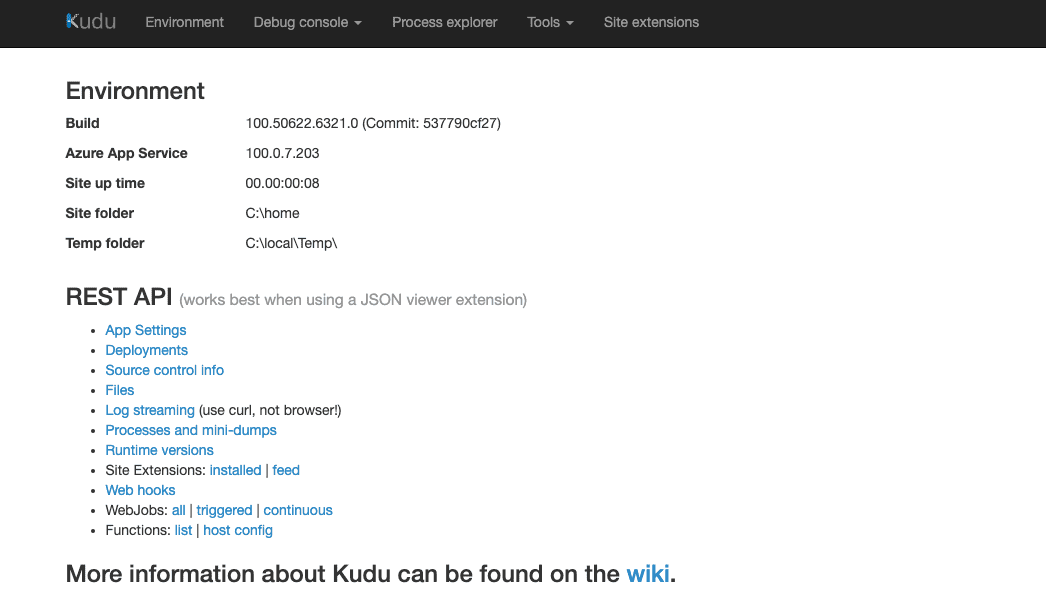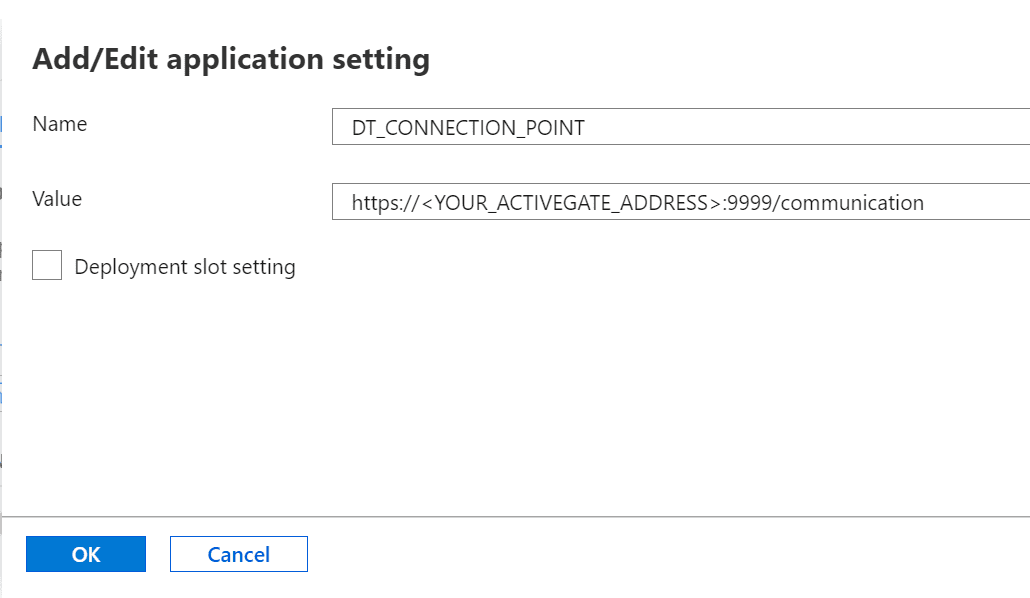Integrate OneAgent on Azure App Service for Windows
Azure App Service provides many different hosting options for Windows, Linux, and containers with shared infrastructure (App Service plan), or fully isolated and dedicated infrastructure (Azure App Service Environment).
Capabilities
The App Service integration with Dynatrace provides the following capabilities:
- Integration for OneAgent on Windows via an extension for easy deployment
- Integration for OneAgent on Linux and containers
- Automatic distributed tracing and monitoring for .NET/.NET Core, Java, Node.js, PHP, and IIS
- Enhanced capturing of Azure App Service metadata, such as SKU or Website-Name
- Capturing of platform-level metrics and additional insights into your App-Service Plan via the Azure Monitor integration
- Capturing of logs via log forwarding
Limitations
Since Azure App Service is a fully managed hosting platform, applications are deployed into a sandboxed environment that doesn't allow direct access to the underlying operating system. The OneAgent integration for Azure App Service uses the application-only or universal injection approach, which results in some differences from the Full-Stack OneAgent installation:
- I/O monitoring requires that you enable Azure Monitor integration, which also provides additional insights into your App-Service Plan
- Capturing logs requires that you enable log forwarding
- Automatic OneAgent updates need to be triggered via the Dynatrace OneAgent site extension REST API
- Hostgroup configuration is not available
Install Dynatrace OneAgent site extension
Windows only
Dynatrace provides a site extension to install OneAgent on Azure App Services on Windows.
For Azure App Service on Linux or containers, see Integration for OneAgent on Azure App Service on Linux and containers.
Site extension is the native extension mechanism provided via Kudu, which is the deployment management engine behind Azure App Services.
The Dynatrace OneAgent site extension doesn't include the OneAgent installer. Instead, the extension uses the Dynatrace REST API to download the installer from the cluster in the target version as set in OneAgent updates.
There are multiple ways to install the Dynatrace OneAgent site extension:
See below for instructions.
Prerequisites
-
Create a PaaS token.
-
Determine your environment ID.
-
Determine your server URL if required.
The server URL is required only if you an ActiveGate for a Dynatrace SaaS endpoint. The URL is automatically generated from the environment ID.
- ActiveGate server URL:
https://<your-active-gate-IP-or-hostname>:9999/e/<your-environment-id>/api(the ActiveGate port is configurable)
- ActiveGate server URL:
Manual install via Azure Portal
-
In Azure Portal, go to the App Services and select an app service where you want to add the OneAgent extension.
-
In the left menu, go to to Development Tools > Extensions.
-
Select Add.
-
Select Choose an Extension.
-
From the list of extensions, select Dynatrace OneAgent.
-
Accept legal terms and select Add. It should take a moment until you see the Dynatrace OneAgent extension on the list.
-
In the left menu, go to to Development Tools > Advanced Tools and select Go. This will redirect you to the Kudu site.

-
Select Site extensions.
-
Select Launch on the Dynatrace tile.
-
On the Start monitoring your App Service instance page, enter your environment ID, PaaS token, and server URL. See Prerequisites section for details.
-
optional You can select Accept all self-signed SSL certificates to automatically accept all self-signed TLS certificates.
-
Select Install OneAgent.
-
To check the deployment status, go to Deployment Status.
-
After installation is complete, go to Site extension tab in Kudu and select Restart Site.
-
Restart the App Service application to recycle the application's worker process
After restart, OneAgent starts monitoring your application automatically.
Automatic install using an ARM template
As an alternative to installing via Azure Portal, you can make the Dynatrace site extension part of your ARM templates.
Note that the example configuration provided below is a template and some values need to be modified.
Example configuration:
{"$schema": "https://schema.management.azure.com/schemas/2019-04-01/deploymentTemplate.json#","contentVersion": "1.0.0.0","parameters": {// WebApp Settings"siteName": {"type": "string","metadata": {"description": "Web app name where you would like to install extension."}},"location": {"type": "string","metadata": {"description": "Region of your web app."}},"skuCapacity": {"type": "int","defaultValue": 1,"minValue": 1,"metadata": {"description": "Describes plan's instance count."}},"skuName": {"type": "string","defaultValue": "B1","allowedValues": ["B1","B2","B3","D1","F1","I1","I1v2","I2","I2v2","I3","I3v2","P1V2","P1V3","P2V2","P2V3","P3V2","P3V3","PC2","PC3","PC4","S1","S2","S3"],"metadata": {"description": "Describes plan's pricing tier and instance size. Check details at https://azure.microsoft.com/en-us/pricing/details/app-service/."}},"webAppAlwaysOn": {"type": "bool","metadata": {"description": "If AlwaysOn isn't set to true, installation of OneAgent is triggered on the start-up/first request to Kudu."},"defaultValue": true},// Dynatrace OneAgent site extension settings"environmentID": {"type": "string","metadata": {"description": "The environment ID."}},"APIToken": {"type": "string","metadata": {"description": "The PaaS token."}},"APIUrl": {"type": "string","metadata": {"description": "The server URL, if you want to configure an alternative communication endpoint."}},"SSLMode": {"type": "string","metadata": {"description": "To automatically accept all self-signed TLS certificates, set the value to all."},"allowedValues": ["default", "all"],"defaultValue": "default"},"monitoredCLR": {"type": "string","metadata": {"description": "Your .NET application runtime"},"allowedValues": ["both", "coreclr", "clr"],"defaultValue": "both"},"networkZone": {"type": "string","metadata": {"description": "Your network zone. Set the value you want for your App Service instance. See network zones for more information."},"defaultValue": ""}},"resources": [{"apiVersion": "2020-12-01","name": "[parameters('siteName')]","type": "Microsoft.Web/serverfarms","location": "[parameters('location')]","sku": {"name": "[parameters('skuName')]","capacity": "[parameters('skuCapacity')]"},"properties": {"name": "[parameters('siteName')]"}},{"apiVersion": "2020-12-01","name": "[parameters('siteName')]","type": "Microsoft.Web/sites","properties": {"name": "[parameters('siteName')]","siteConfig": {"alwaysOn": "[parameters('webAppAlwaysOn')]","appSettings": [{ "Name": "DT_TENANT", "Value": "[parameters('environmentID')]" },{ "Name": "DT_API_TOKEN", "Value": "[parameters('APIToken')]" },{ "Name": "DT_API_URL", "Value": "[parameters('APIUrl')]" },{ "Name": "DT_SSL_MODE", "Value": "[parameters('SSLMode')]" },{ "Name": "DT_MONITORED_CLR", "Value": "[parameters('monitoredCLR')]" },{ "Name": "DT_NETWORK_ZONE", "Value": "[parameters('networkZone')]" }]},"serverFarmId": "[resourceId('Microsoft.Web/serverfarms', parameters('siteName'))]"},"dependsOn": ["[concat('Microsoft.Web/serverfarms/', parameters('siteName'))]"],"location": "[parameters('location')]","resources": [{"apiVersion": "2020-12-01","name": "Dynatrace","type": "siteextensions","dependsOn": ["[resourceId('Microsoft.Web/sites/', parameters('siteName'))]"]}]}],"outputs": {}}
AlwaysOn isn't set to true, OneAgent installation is triggered at startup (on the first request to Kudu).all.clr if your application is running on .NET, or coreclr if your application is running on .NET Core, default value is bothTo check the deployment status, go to Deployment Status.
After installation is complete, restart the App Service application to recycle the application's worker process. After restart, OneAgent starts monitoring your application automatically.
Automate the installation using a PowerShell script
You can automate the installation with a PowerShell script that uses the Kudu REST API, OneAgent site extension REST API, as well as the Azure CLI. A sample implementation is available in the Dynatrace GitHub repository.
Dynatrace OneAgent site extension REST API
The Dynatrace OneAgent site extension provides a REST API to automate OneAgent installation, configuration, and update.
The root URL to access the REST API is https://<Your-AppService-Subdomain>.scm.azurewebsites.net/dynatrace/, where you need to replace <Your-AppService-Subdomain> with your own value. To authenticate, you can use either the user publishing credentials or the site-level credentials. For details, see Accessing the Kudu service.
The returned
state field can be:-
NotInstalled-
Downloading-
Installing-
Installed-
FailedFor automation purposes, use the isAgentInstalled and isUpgradeAvailable fields to check whether the OneAgent is installed and whether an upgrade is available.
{ "state": "Installed", "message": "OneAgent installed", "version": "1.157", "isAgentInstalled": true, "isUpgradeAvailable": false, "isFunction": false, "functionAppSettings": null}{"apiUrl": "","apiToken": "<your-api-token>","environmentId": "<your-environment-id>","sslMode": "Default"}In the payload, you need to send the data in the same format as received by the
GET /dynatrace/api/settings request.If there's an update available in the status request, this
PUT request can be used to start the upgrade.Notes:
* The value for
apiUrl can be left empty for a SaaS environment.* For
sslMode, if you want to validate the HTTPS connection, leave it as Default. If you don't want to validate the HTTPS connection, set it to AcceptAll.Using multiple deployment slots
Because Azure App Service deployment slots are treated like full-fledged application service instances, you need to enable the site extension for OneAgent on each deployment slot you want to monitor with Dynatrace.
For details on configuring deployment slots, consult the Microsoft documentation.
If you're using application settings to additionally configure certain OneAgent options, make sure the additional settings are also applied to the deployment slots.
Using App Service built-in authentication and authorization
If you use App Service built-in authentication and authorization capabilties (also referred to as "Easy Auth"), App Service starts an additional .NET CLR instance, which makes OneAgent instrument the Easy Auth module instead of your application's instance as the leading instance.
In this case, if your application process isn't instrumented, you need to set the DT_MONITORED_CLR environment variable to instance that your application is running on: clr or coreclr.
You can set this variable in Azure Portal (Settings > Configuration > Application Settings).
Override OneAgent configuration
To override the default configuration, you can use the following parameters.
-
In Azure Portal, select the web application you want to monitor.
-
Select Settings > Configuration > Application Settings.
-
Select New application setting.
-
Enter the configuration key/value pair like this.
- Name:
DT_CONNECTION_POINT - Value:
https://<YOUR_ACTIVEGATE_ADDRESS>:9999/communication, making sure to replace<YOUR_ACTIVEGATE_ADDRESS>with your own value.

- Name:
-
Select OK to save the configuration.
Using Application Insights
OneAgent may not be able to instrument your .NET/.NET Core application if you use Application Insights with runtime instrumentation enabled. This is because OneAgent and Application Insights try to use the same interface to inject at runtime.
Please review your Application Insights configuration for Asp.Net, where you can turn off runtime instrumentation or Asp.Net Core auto-instrumentation.
While you may still be able to use Application Insights in basic mode or SDK in parallel with Dynatrace OneAgent, please note that this may cause other issues or significant monitoring overhead to your applications and isn't recommended.
Update the Dynatrace OneAgent site extension
To update the Dynatrace OneAgent site extension
- In Azure Portal, go to your Azure App Service with Dynatrace OneAgent site extension.
- If an update is available, select Update.
When upgrading the extension from version 1.x to version 2.x, if you have Always On selected on your App Service, the upgrade of OneAgent is either triggered automatically or on the first request to the UI extension. If you don't have Always On selected, you must restart App Service, so that the extension process starts.
An update to the Dynatrace OneAgent site extension doesn't force a OneAgent update. To update OneAgent, see Dynatrace OneAgent.
Update OneAgent
The Dynatrace OneAgent site extension doesn't provide Dynatrace OneAgent updates automatically. To update Dynatrace OneAgent on Azure App Service
- In Azure Portal, go to your Azure App Service with Dynatrace OneAgent site extension.
- In the Development Tools section, choose Advanced Tools and select Go. This will redirect you to the KUDU website.
- Go to Site extensions > Installed > Dynatrace.
- If an update is available, select Upgrade OneAgent.
You can monitor the progress until the update is complete, and then restart App Service to recycle the application worker process.
Automate OneAgent updates
To automate OneAgent update, the Dynatrace OneAgent site extension provides a REST API that can be used to trigger updates. See REST API for details.
Uninstall Dynatrace OneAgent site extension
Removing the Dynatrace OneAgent site extension also removes Dynatrace OneAgent. If the application is running at the time of removal, the site extension recognizes the running application and, to prevent issues with the application, does not remove any Dynatrace artifacts. Instead, only the site extension, including the configuration, is removed, so that Dynatrace OneAgent is no longer active the next time the application restarts.
Monitoring consumption
For Azure App Service, monitoring consumption is based on host units. See Application and Infrastructure Monitoring (Host Units) for details.
Troubleshoot
- The log files for the extension are in the extensions folder:
D:\home\SiteExtensions\Dynatrace\. - OneAgent log files are located in
D:\home\SiteExtensions\Dynatrace.Agent\x.xxx.xxx.xxxxxxxx-xxxxxx\log. You might have multipleD:\home\SiteExtensions\Dynatrace.Agent\subdirectories caused by agent updates.